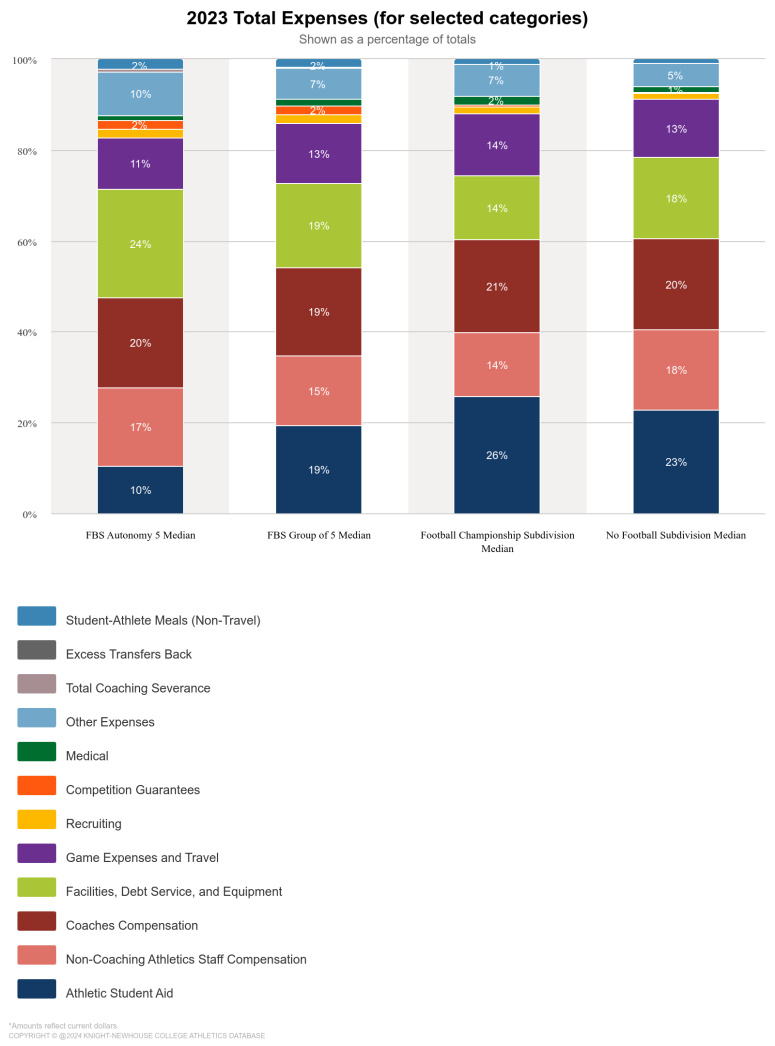Learn more about the Knight Commission’s efforts to ensure that athletics programs are operating within the educational mission of their universities. The following information can be found on this page:
Knight-Newhouse College Athletics Database
Watch the video to understand why the database exists and how it is used by decision makers, journalists, researchers, and students.
About the Knight-Newhouse College Athletics Database
The Commission believes that the effective oversight of college sports across all NCAA Division I institutions requires the availability of clear, comparable, and complete financial data. Sustaining intercollegiate athletics also requires strategies to improve accountability.
The database was created in 2013 to implement one of the Knight Commission’s recommendations in its 2010 report, Restoring the Balance: Dollars, Values and the Future of College Sports. The report called for greater transparency of athletics finances by NCAA Division I institutions, including better measures to compare trends in athletic and academic spending.
In 2021, the Knight Commission partnered with Syracuse University’s S.I. Newhouse School of Public Communications to enhance the database and continue its broad accessibility to decision-makers, athletes, journalists and the general public.
Knight-Newhouse College Athletics Database Tutorial
Throughout its history, the Knight Commission has worked to advance financial transparency and a better understanding of athletics revenues and expenses. An understanding of athletics finances is critical to the development and design of effective policies. The Commission’s past reports highlight critical aspects of athletics finances and efforts to improve financial accountability.
The financial data in this database are organized to show "Where the Money Comes From" (revenue) and "Where the Money Goes" (expenses) for each public Division I institution, athletics conference and each of the three DI subdivisions.
Below are two graphs that provide aggregate data for Division I to explain “Where the Money Goes” and “Where the Money Comes From”.
College Athletics Database Tutorial
“Where The Money Goes”
Distribution of Athletic Expenditures for Division I Public Institutions, 2023

This graph shows the major operating expenses for each Division I Subdivision and the Autonomy 5 and Group of 5 institutions in the Football Bowl Subdivision (FBS). Definitions and examples of spending in each category can be found in the "About the Data and Methodology" section of this database.
The 2023 data are based on 52 public institutions classified in the Autonomy 5 of the Football Bowl Subdivision; 55 public institutions in the Group of 5 of the Football Bowl Subdivision; 78 public institutions in the Football Championship Subdivision and 46 public institutions in Division I that do not sponsor football.
Source: Knight-Newhouse College Athletics Database.
“Where the Money Comes From”
Sources of Athletic Budget Revenue for Division I Public Institutions, 2023

This graph shows the major operating revenues for each Division I Subdivision and the Autonomy 5 and Group of 5 institutions in the Football Bowl Subdivision (FBS). Definitions and examples of each revenue category can be found in the "About the Data and Methodology" section of this database.
The 2023 data are based on 52 public institutions classified in the Autonomy 5 of the Football Bowl Subdivision; 55 public institutions in the Group of 5 of the Football Bowl Subdivision; 78 public institutions in the Football Championship Subdivision and 46 public institutions in Division I that do not sponsor football.
Source: Knight-Newhouse College Athletics Database.
About the Knight Commission on Intercollegiate Athletics
The mission of the Knight Commission on Intercollegiate Athletics is to develop, promote and lead transformational change that prioritizes the education, health, safety and success of college athletes. The Commission was formed by the John S. and James L. Knight Foundation in October 1989. The Commission has a legacy of designing and influencing principles and policies adopted by the NCAA and/or by individual athletics conferences. One example is the NCAA’s academic policy that requires teams to be on track to graduate at least 50 percent of their players to be eligible for postseason competition.. To preserve the Commission’s independence, Knight Foundation continues to be its sole supporter, but does not control, or attempt to control, the Commission’s opinions.
About the Data and Methodology
This database uses data collected from NCAA Division I institutions that are required to provide information based on state public records laws. The data are self-reported by institutions on NCAA Financial Report Forms, which are filed with the NCAA annually. Public higher education institutions are required to make the NCAA forms available, except in states with explicit exemptions (Pennsylvania, for example). The U.S. Military Academy (Army), U.S. Air Force Academy, Pennsylvania State University and others with exemptions have periodically provided data; years with missing data may have an impact on totals or medians when the institution is included.
Each profile page for an institution, conference, or subdivision contains a financial snapshot of the most recent reporting fiscal year. Data from earlier years dating back to 2005 are also available. Trends over time showing percent change in budgets and in aggregate revenue and expense categories are available by using the Custom Reporting feature.
The raw financial data can be accessed using the “download data” tool throughout the database. For information about the data, methodology, definitions, and sources, go to About the Data.

